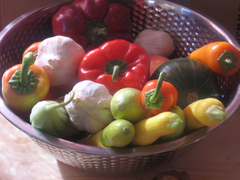- Details
- Created: Monday, 08 December 2014 17:40
- Last Updated: Wednesday, 07 March 2018 20:20
Why are we here? What are we doing?
People are critters with the same basic needs of other animals. The quality and availability of air, water, food and shelter places limits on how many people can exist. We use energy to do the work that makes these basic resources available.
We have a big problem, however. Most of the materials we rely on for our survival come from far away places. Our food is shipped from hundreds to thousands of miles away. Since it takes water to grow food, we are essentially importing water as well. Our primary energy sources, fossil fuels and the electricity generated by them, are all imported via transmission wires, pipelines and tanker trucks. And they are non-renewable, meaning they will some day become progressively less available.
That day may be soon. In sum, we are part of a global economy that is highly reliant on depleting resources, and that damages ecological systems. This means we have little control over, or even awareness of, the processes that sustain our lives and are actively undermining the function of basic environmental services, such as climate regulation. We have created a situation both insecure and irresponsible.
The reverse of this predicament would be a locally sustainable economy. I use the rubric “Economic Localization” for the as yet undefined process we will go through to create this system of living. Being local gives us an understanding of and control over how our economy works. Being sustainable means we are living off of the reliable income of solar energy and recycling essential nutrients back to the land so that fertility is maintained.
The contrast between a locally sustainable economy and the globally unsustainable one we now rely on is dramatic. Facing such a change can be both daunting and inspiring. I’ll sketch out a vision of what this new economy might look like.

Nearly all our food would be produced and consumed within the Little Lake Valley. We would know our farmers, and indeed many of us would be farmers at least part time. Food would be high quality and clean, grown using non-polluting, life-promoting methods. The local landscape would be a vibrant mosaic of colorful, ever-changing fields, interspersed with restored native habitats.
To move around, we would rely mainly on our own muscle power. Instead of hitting the gym for a workout, we’d be walking and biking to and fro. The sound and smell of cars and trucks would be a distant memory. Some electric vehicles would still help a bit, but these would have a quiet hum. Railroads may come
alive again. Kids could explore their neighborhoods without the fear of being flattened. The creative energy of our friends and neighbors would make life interesting.
Processing, storage and preparation of our local food would become a form of functional art. Locally produced crafts of all kinds would be needed. The tools for basic living would take on the character of the people making them. Things of
lasting value would be revered and the irrelevant or cheap ignored and discarded. This would enhance our interpersonal relationships and the quality of the environment we co-create.
We would develop a profound awareness of the beautiful cycles of life and know our place within these. The universal values of personal integrity, good work, community, and appreciation of our diverse talents would become ingrained in
the population.
So let’s make this process an exciting challenge. Whether you are mainly motivated by fear, hope, desire or a combination of all these doesn’t really matter. The key is that you remain committed and engaged in some way. We will make use of whatever your particular interests and talents are because this is a big, long-term project that will evolve and require many skills.
The formation of Willits Economic LocaLization























